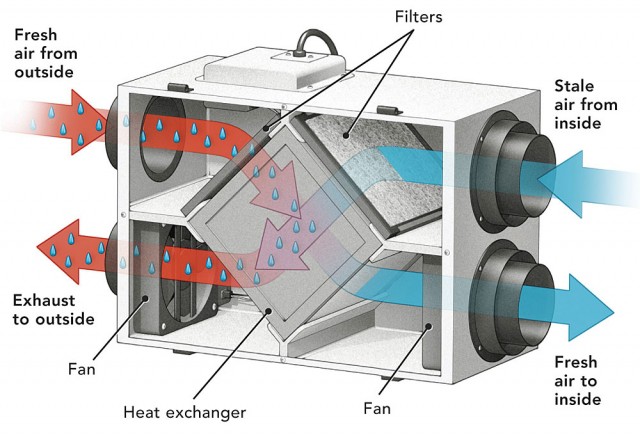The Importance of HRV in Sustainable Living
Just How Heat Recovery Ventilation Improves Indoor Air Quality and Reduces Energy Costs
Heat Recovery Ventilation (HRV) systems play a vital role in boosting indoor air top quality while concurrently lowering power expenses. By successfully exchanging stagnant indoor air with fresh exterior air, HRVs assist keep suitable humidity and reduce pollutants. In addition, their capability to recoup warm from outward bound air reduces the pressure on heating and cooling down systems. As power expenses proceed to rise, comprehending the full potential of HRV systems ends up being significantly essential for home owners and companies alike.
Comprehending Heat Recovery Ventilation Systems

Heat recovery ventilation (HRV) systems play a vital duty in enhancing indoor air top quality, particularly in contemporary, energy-efficient structures. These systems are developed to transfer warmth from the outgoing stagnant air to the incoming fresh air, therefore lessening power loss while keeping perfect temperature level levels inside your home. HRVs are composed of a heat exchanger, followers, and ductwork, assisting in the continual circulation of air. By getting rid of indoor contaminants and presenting fresh air, HRVs assist to stabilize humidity levels, protect against mold growth, and decrease allergens. The effectiveness of HRV systems lies in their capability to recuperate as much as 80% of the warm from the worn down air, advertising power preservation while making sure a healthy indoor atmosphere. Their integration is vital in attaining sustainable living methods.
The Significance of Indoor Air Quality
Indoor air quality (IAQ) is an essential element influencing the wellness and health of owners in any kind of setting. Poor IAQ can bring about different wellness concerns, consisting of respiratory system issues, allergic reactions, and fatigue. Additionally, it can worsen current conditions such as asthma. Variables adding to low IAQ include toxins from interior sources like cleansing representatives, mold, and inadequate ventilation. Keeping great IAQ is vital for promoting a safe and comfy living or functioning area. Effective approaches to enhance IAQ entail routine surveillance of air high quality, proper air flow systems, and minimizing making use of unsafe compounds indoors. By prioritizing IAQ, individuals can ensure a much healthier atmosphere that cultivates efficiency and total lifestyle.
Energy Effectiveness Conveniences of HRV Systems
Numerous house owners and structure supervisors are increasingly acknowledging the power effectiveness advantages of warmth recovery ventilation (HRV) systems. By transferring warm from tired interior air to inbound fresh air, HRV systems noticeably decrease the energy needed for heating & site link cooling. This procedure lessens dependence on typical HVAC systems, leading to lower energy bills. Additionally, HRVs help preserve a balanced indoor climate, avoiding extreme heating or cooling demands. The ability to recoup approximately 90% of the heat from outgoing air also sustains sustainability initiatives by lowering total power usage. As a result, HRV systems contribute not only to set you back financial savings however also to a reduced carbon impact, aligning with the expanding emphasis on energy-efficient structure practices.
Setup and Upkeep Considerations
The reliable execution of warmth recuperation air flow (HRV) systems calls for mindful factor to consider of setup and upkeep variables to assure peak performance. Correct positioning of the HRV system is important, as it should be set up in a location that makes the most of air movement while lessening noise interruption. In addition, ductwork needs to be suitably see here sized and shielded to avoid power loss. Routine maintenance, including filter substitute and system cleaning, is critical to secure optimum performance and indoor air high quality. Proprietors should develop a normal maintenance routine to recognize and attend to prospective problems prior to they escalate. Partnership with knowledgeable specialists throughout both setup and maintenance stages can improve the longevity and efficiency of HRV systems, eventually bring about better indoor settings and reduced power prices.
Real-World Applications and Success Stories
Discovering real-world applications of warm healing ventilation (HRV) systems discloses their substantial impact on indoor air quality and power performance across various setups. In property structures, homeowners have reported enhanced air quality, resulting in less allergic reactions and breathing concerns. Schools implementing HRV systems have kept in mind enhanced student concentration and minimized absenteeism due to far better air flow. Industrial buildings, such as workplaces and retail spaces, have actually experienced reduced energy prices and raised employee performance. A company office in a pleasant climate accomplished a 30% reduction in power costs after setting up an HRV system. These success tales demonstrate that HRV modern technology not only adds to healthier settings however likewise provides substantial financial advantages, making it a useful investment for different markets.
Frequently Asked Concerns
Can HRV Equipments Decrease Allergens in Indoor Air?
The effectiveness of HRV systems in decreasing indoor irritants mainly hinges on their ability to filter and exchange air. HRV Heat Recovery Ventilation. By continually replacing stale air, these systems can considerably lower allergen levels throughout interior settings

Just How Does Humidity Affect HRV System Performance?
Humidity greatly influences HRV system performance; high levels can result in condensation, minimizing effectiveness, while low moisture may improve air exchange. Balancing moisture is vital for suitable procedure and preserving indoor a knockout post air quality.
Are HRV Systems Noisy During Procedure?
HRV systems can create differing sound degrees throughout operation, depending on their style and installation. Some systems run quietly, while others might generate obvious audio, specifically at higher airflow settings or when improperly maintained.
What Is the Typical Life-span of an HRV System?

Can HRV Solutions Be Made Use Of in All Climates?
HRV systems can be utilized in various environments, however their performance might differ - HRV Heat Recovery Ventilation. In extreme temperature levels, modifications or supplemental systems may be required to guarantee suitable efficiency and convenience while preserving interior air quality